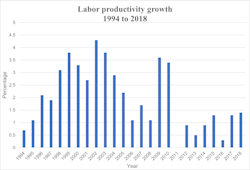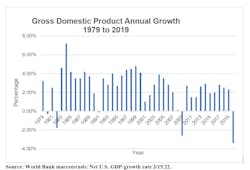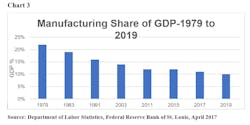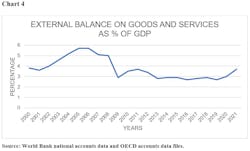Reviving Manufacturing Is the Only Way to Economic Growth
OPINION
There is a general assumption by many economists that the erosion of American manufacturing is an acceptable premise in a changing economy. They say that just as the economy progressed from an agricultural economy in the early 20th century to an industrial manufacturing economy, it is now changing to a service economy.
The assumption was that this transition is a healthy and natural process of economic evolution, and that economy and living standards will continue to grow. But instead, the transition has become a decades-long experiment in deindustrialization and is testing the assumption that we can thrive in a post-industrial economy.
There are four principal reasons why we must abandon this experiment before it is too late.
1. Labor productivity growth
Growth in labor productivity, defined as output per labor hour, has slowed since 2005. Chart 1 shows productivity growth since 1994. But since 2005, the average annual productivity growth rate is 1.3% – well under the average of 2.1%, going back to 1947. The primary cause of reduced productivity and economic growth is globalization and deindustrialization.
Chart 1
Source: Department of Labor Statistics, labor productivity growth, annual percent changes, non-farm business sector, 1994 to 2018
Weak productivity growth results in slow economic growth, and a decline in wages and living standards. The U.S. Bureau of Labor Statistics says this slowdown has resulted in the cumulative loss of $10.9 trillion in output in the non-farm business sector. This corresponds to a loss of $95,000 in output per worker.
2. Gross domestic product growth
Chart 2 shows GDP growth percentages back to 1979. There were several decades where the US enjoyed 3-4% GDP growth, but since 2000 it has been an anemic 1.8%.
Chart 2
3. GDP devoted to manufacturing
In his report “The Twin Secrets of Economic Growth,” economist Jeff Ferry of the Coalition for a Prosperous America says that “two important indicators provide the best explanation of the secrets of economic growth”: the share of a nation’s gross domestic product devoted to manufacturing, and the net level of goods and services exported as a share of GDP.
Importantly, Ferry provides data that makes clear that “manufacturing is a key contributor to growth because it is the only sector that can create multi-decade broad-based increases in labor productivity, which is the key to rising wages.”
Ferry goes on to say that “a nation with a significant current account deficit is always in trouble because it is losing share of either its foreign market or its domestic market or both”[i]. It also results in loss of economic growth.
Consequently, America now suffers from low productivity and a decline in GDP growth. The only answer is to refocus on increasing manufacturing’s share of GDP and to reduce the trade deficit.
4. Growth of the trade deficit
Current account trade balance is a census department title for the export of goods and services. A trade deficit occurs when a country imports more goods and services than it exports.
Economists who support free trade and trade deficits so that we can import cheap goods seldom mention that millions of people have lost their jobs, inequality is rising, we have lost industries and technologies and we had to finance $12 trillion of debt. I believe that the only way to improve economic growth and living standards is to reduce the trade deficit, increase exports and grow manufacturing as a percentage of GDP.
The Five Reasons the Manufacturing Sector is Important
1. R&D and American innovation. Just about everybody from the conservative right to the liberal left believes that innovation is the primary strategy that America must depend on to compete in the global economy. But the loss of our technologies through partnerships, unfair trade, technology transfer and outsourcing has shown that we are fast losing our technologies to countries like China. Outsourcing and technology transfer agreements are a contradiction to any innovation strategy. Fifty-eight percent of private R&D comes from manufacturing, not services, so increasing manufacturing R&D in the U.S. is the key to an innovation strategy.
2. Advanced technology products. An analysis by the Brookings Institution defines 50 U.S. industries as advanced technology industries (ATIs). Thirty-five are manufacturing industries, including optoelectronics, nanotechnology, artificial intelligence, advanced robotics, advanced materials, self-driving cars and weapons systems. In fact, this technological leadership is the key to economic power and remaining the largest economy in the world. But America has been running trade deficits in the ATI since 2002, and many of these technologies are now made overseas. If we can’t stop this ongoing loss of technology or reshore manufacturing industries, there is little chance that we will be able to compete with a strategy of innovation
3. Exports. In 2022, we exported $2.1 trillion of goods and imported $3.3 trillion of goods, for a trade deficit of $1.2 trillion. Sixty-seven percent of our exports are manufactured goods—so if we are going to have any chance of increasing exports, the only answer is to reduce the trade deficit and decrease outsourcing. Services are only 27% of our exports, so increases of service exports simply won't do it.
4. Manufacturing is key to our national defense. A government-wide assessment of America’s manufacturing and military industrial base identifies almost 300 vulnerabilities, ranging from dependencies on foreign manufacturers to looming labor shortages. We can't have strong national security if we continue to outsource components and critical materials to low-cost countries. The only way to stop these critical products and technologies from falling into the hands of our competitors is for the government to declare some of them critical to national security and declare them off limits to foreigners.
5. Manufacturing as the foundation of global power. From the rise of England in the 19th century, to the rise of America, Japan, and Germany in the 20th century and the rise of China, Taiwan, and Korea in the 21st century, manufacturing has been the key to the growth and power of each country. In my article, Is U.S. Manufacturing Losing Its Toolbox?, I showed that machine shops, machine tools, forging, stamping, semiconductors, hand tools and many machinery industries that are the tools of production are all declining. The primary point is that to remain a global power, America must have a strong manufacturing base.
No other sector in the economy can achieve these goals. We won’t maintain our position as the world’s largest economy as a service economy. All of these charts seem to indicate that in 1979 America reached the “high noon” of the American Century and we have been declining ever since.
Unless the government and industry leaders decide to do something about it, I am afraid the country is in for a hard economic landing. U.S. multinational corporations have hacked a prime cut out of the carcass of America by outsourcing, and it is about time they pitch in and help us out of the mess they and the government have created. Former U.S. Trade Representative Robert Lighthizer summarized the dilemma when he said, “No country ever became rich by consuming; they got rich by producing.”
Michael Collins is the author of “Dismantling the American Dream: How Multinational Corporations Undermine American Prosperity.” He can be reached at mpcmgt.net.




